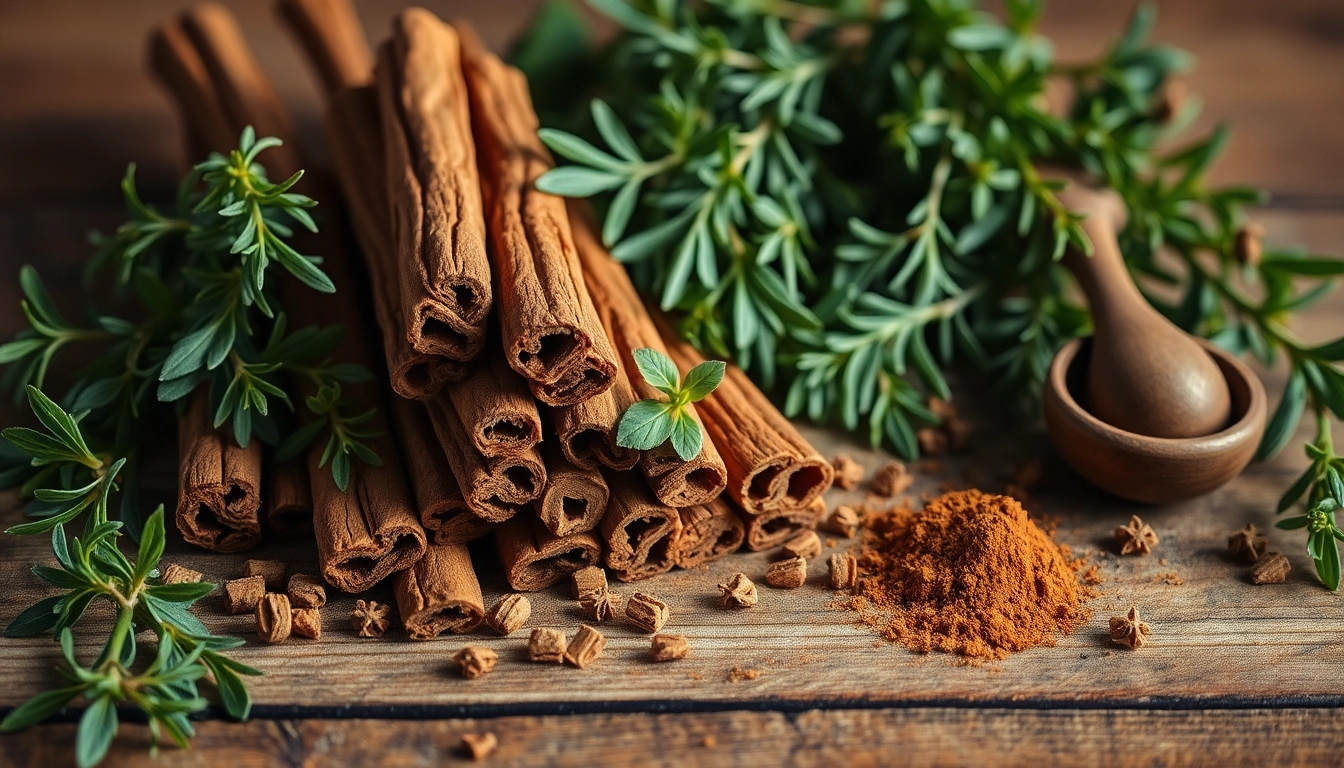
What is Cinnamon Bark?
Cinnamon bark, derived from the inner layer of the trunk of trees belonging to the genus Cinnamomum, has been cherished for centuries not just as a spice but also for its myriad health benefits. The most common varieties of cinnamon include Ceylon (true cinnamon) and Cassia, each with distinct flavors and uses. For those looking to explore the sensory and health benefits of this remarkable spice, Cinnamon Bark offers a rich avenue for discovery.
Understanding Cinnamon Varieties
Among the various species of cinnamon, Cinnamomum cassia (commonly referred to as Cassia) is the most widely used and is characterized by its thicker and darker bark. In contrast, Cinnamomum verum, or Ceylon cinnamon, boasts a lighter color and a more complex flavor profile, often considered more desirable for culinary uses. Differentiating between these two types is crucial not only for recipes but also for the specific health benefits each provides.
Distinct Features of Cinnamon Bark
Cinnamon bark is notable for its strong aromatic properties due to the essential oils it contains, particularly cinnamaldehyde, which contributes to its sweet-spicy flavor. Beyond the culinary realm, cinnamon bark also contains numerous antioxidant compounds that contribute to its reputation as a superfood. This unique chemical composition allows cinnamon bark to offer various health benefits, making it a versatile addition to both dishes and dietary supplements.
Historical Significance and Cultural Uses
Cinnamon has a rich history dating back over 4,000 years, mentioned in ancient Chinese writings and associated with various cultural practices across Asia, the Middle East, and Europe. It was once more valuable than gold and was used not only in cooking but also in funerary rites and medicinal practices. Today, it continues to be an integral part of cultures worldwide, featured in everything from baked goods to traditional herbal medicine.
Health Benefits of Cinnamon Bark
Cinnamon bark is more than just a flavorful addition to your spice rack; it offers a range of health advantages supported by scientific research. Below are some key benefits of incorporating cinnamon bark into your daily diet.
Antioxidants and Anti-inflammatory Properties
One of the most notable health benefits of cinnamon bark is its high concentration of antioxidants. These compounds help combat oxidative stress and inflammation in the body, which are linked to chronic diseases such as heart disease and diabetes. Studies suggest that cinnamon may help reduce markers of inflammation and oxidative damage, making it a valuable addition to an anti-inflammatory diet.
Digestive Health Advantages
Cinnamon bark has long been used as a remedy for various digestive issues, including bloating, gas, and diarrhea. Its properties appear to stimulate digestion and alleviate gastrointestinal discomfort. Using cinnamon bark in teas or sprinkled over foods can promote gut health and improve overall digestion.
Impact on Blood Sugar and Heart Health
Research has demonstrated that cinnamon bark can assist in regulating blood sugar levels and improving insulin sensitivity. This is particularly beneficial for individuals with diabetes or those at risk of developing the condition. Furthermore, cinnamon may help lower cholesterol levels and reduce the risk of heart disease, making it an essential ingredient in a heart-healthy diet.
How to Use Cinnamon Bark in Cooking
Cinnamon bark’s versatility extends into the kitchen, where it can elevate dishes with its rich flavors. Here are several ways to effectively incorporate it into your cooking endeavors.
Incorporating Cinnamon Bark in Recipes
To fully harness the flavor of cinnamon bark, it is often used whole or in stick form. This allows it to infuse flavor into soups, stews, and marinades. Additionally, it can be ground into powder for baking, adding depth to sweet and savory dishes alike.
Cinnamon Bark vs. Ground Cinnamon: What’s the Difference?
While both forms come from the same plant, cinnamon bark is generally more potent in flavor compared to ground cinnamon. Whole sticks are ideal for infusion in liquids, whereas ground cinnamon is more suitable for baked goods or as a finishing touch for dishes. Understanding the differences can significantly enhance your culinary experiences with cinnamon.
Creative Ways to Enhance Flavor with Cinnamon Bark
Beyond conventional uses, consider innovative applications of cinnamon bark. For example, it can be used in spice blends, such as curry powders or chai mixes, or even in homemade apple cider for a warming beverage in the cooler months. The possibilities are limited only by your creativity!
Potential Side Effects and Precautions
Despite its many advantages, caution should be exercised when consuming cinnamon bark, as excessive intake may lead to adverse effects.
Understanding Safe Dosage
The acceptable daily intake of cinnamon bark varies depending on the individual, but it is generally recommended to limit consumption to no more than 1 teaspoon (2-4 grams) per day. Higher doses could lead to potential liver toxicity due to the presence of coumarin, particularly in Cassia cinnamon.
Who Should Avoid Cinnamon Bark?
Certain individuals, such as pregnant or breastfeeding women, and those with specific health conditions (e.g., liver disease) should consult healthcare professionals before incorporating cinnamon bark into their diets. Furthermore, those on anticoagulant medications should be cautious due to cinnamon’s potential blood-thinning effects.
Interactions with Medications
Cinnamon bark may interact with various medications, including those for diabetes or anticoagulants. It is essential for individuals on such medications to seek professional advice when considering cinnamon supplementation or increased dietary intake.
Where to Buy High-Quality Cinnamon Bark
When purchasing cinnamon bark, quality is vital to ensure you reap all its benefits. Here are some tips for obtaining the best product.
Identifying Authenticity: True Cinnamon vs. Cassia
It’s essential to recognize the differences between Ceylon (true) cinnamon and Cassia to make informed purchasing decisions. Ceylon cinnamon is generally more expensive but is preferred for its superior flavor and lower coumarin content. Look for labels indicating the product is “Ceylon” or “Cinnamomum verum” for authenticity.
Recommended Brands and Sources
Reputable brands offering high-quality cinnamon include Spice Jungle and Simply Organic, which provide organic, ethically sourced products. Moreover, consider local health food stores or specialty spice shops that focus on premium quality.
Storage Tips for Freshness
To maintain the freshness of your cinnamon bark, store it in an airtight container in a cool, dark place. Avoid exposure to moisture and heat, which can diminish its aromatic qualities and health benefits over time.







